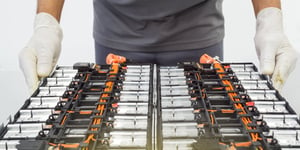If you’ve been online in the past couple of years (which, congratulations, now you have), then you’ve seen videos of electric vehicles bursting into flames. While thermal runaway is the worst-case scenario, you can greatly reduce its risk through proper design.
Every type of electric vehicle contains some form of EV battery insulation to protect it from the consequences of heat and physical damage.
Strouse is dedicated to building products using the best-suited materials for each project. Our team of experts helps select materials, adjust designs, and create electrical and thermal insulation solutions.
While we won’t recommend any specific products below, this article will help you understand the composition of the materials used for EV battery insulation and how to build functional cell bonding applications.
What Materials Are Used to Insulate EV Batteries?
While manufacturers use many different types of adhesives to bond the internal components within EV batteries, insulating materials offer the additional benefit of regulating their internal temperature.
These practical examples should give you an idea of insulation and shock absorption materials to consider. However, remember that many EV designs are innovative and will benefit from alternative materials depending on your application and design.
1. SILICONE POLYMERS (WITH CERAMIC)
Silicone can protect your EV battery design by insulating individual cells from heat or conducting it to other parts of the battery. Electric car battery manufacturers use silicone polymers to increase battery safety without adding additional weight and stress to the surrounding components.
When ceramic is combined with silicone, it creates a highly heat-resistant combination. Technical ceramics are a well-known solution to thermal conductivity due to their strong heat dissipation abilities and can sustain high temperatures for long periods without exceeding their limit (to prevent thermal runaway).
Although ceramic takes longer to heat up, it helps reduce the risk of thermal runaway by encapsulating and sustaining the battery heat to process at a consistent temperature.
Silicone can brace components to prevent damage caused by vibration or sudden movements. Yet, it struggles to adhere to other materials that aren’t itself. If you’re designing a silicone adhesive thermal gap pad, it could become necessary to choose a specialized adhesive for double-sided attachments to non-silicone materials.
2. THERMAL GAP PADS
Thermal gap pads, also known as gap fillers, are a type of thermal interface material that facilitate heat flow and dissipation from heat sources. They are often made out of different kinds of foam and silicone polymers.
Depending on the individual battery design, thermal gap pads might fit between individual battery cells or connect the electric battery to the vehicle’s chassis. While you might find gap filler materials cut into basic shapes online, you may need a converter to produce complex designs or compositions on a larger scale.
Thermal Management for Improved Battery Performance
EV battery thermal insulation controls the internal flow of heat to avoid short circuits and protects the individual components within the battery pack from damage caused by rough movement, a.k.a. collisions.
Minor scrapes on an EV battery can eventually lead to thermal runaway propagation. Even if the thermal runaway was isolated to the modules, the cost of replacing an EV battery might exceed $15,000.
Since electric vehicle battery failure is hazardous, insulating the space between modules and cells and securing the battery to the vehicle are critical facets of any design.
Achieving Proper EV Battery Cell Insulation
One of the best ways to protect your EV battery is to find the most effective insulation and shock absorption design—one that’s functional and practical to manufacture on a large scale.
Part of the product development process involves trying out new, complex material designs to discover the most efficient EV battery creation method.
Testing different types of materials will help you get ahead. If you need suitable materials or testing design adjustments, contact Strouse to test and prototype your EV battery adhesives.
Lastly, investing in EV battery cell-to-cell insulation isn’t the only way to protect your battery from harm. If you feel confident in your insulation but you’re still working on the internal construction, you’ll want to consider EV battery sealing.
Originally published: July 11, 2023







